Following is a group of ingots that all appear to belong together by way of supposed origin, punch style, and lack of deeper information. Furthermore, when reviewed as a group they appear to have parts and traces of each other to carry through as a theme – suggesting a common origin, but possibly not what they purport to be on their face. We dub these the dubious “Colorado Ingot Group”.
A Mr. Stewart ran a reducing works in Georgetown 1874-75. Charles M. Moor appears unknown beyond the fact that the bar names him as its assayer. The
name of the mine does not help in establishing a date for the company. This is another ingot about which essentially nothing is known to the cataloguer, or was to Mr. Ford, earlier, beyond the fact of its existence.
The bar does not appear to have been a commercial product as there is no value given. The field of collecting ingots is very young and there are miles of room for new discoveries, research, and the profit that can be made from being the one who knows more than most about it.
6 oz Stewart Silver Reduction Works. Charles M. Moor, Assayer. Silver ingot. Stewart Silver Reduction Works. Charles M. Moor, Assayer. Silver ingot
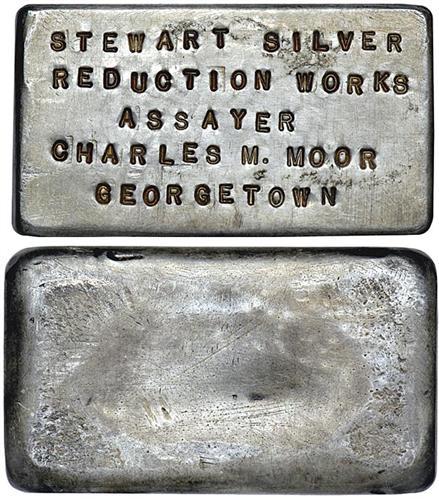
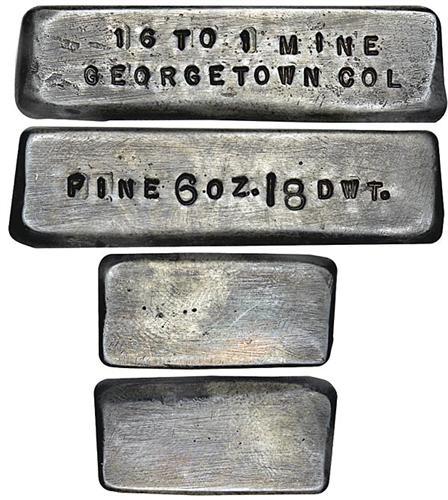
Overall appearance of Extremely Fine. Nice, medium silver gray color. A fairly well made ingot with rounded corners and edges, faces finished for stamping, cooling depression on back partially smoothed down. No logotypes used, one set of letter punches and two of numerals appear on the bar. The mine’s name refers, of course, to the then prevailing ratio of silver to gold.
- Face: STEWART SILVER / REDUCTION WORKS / ASSAYER / CHARLES M. MOOR / GEORGETOWN.
- Back: blank.
- Top side: 16 TO 1 MINE / GEORGETOWN COL.
- Bottom side: FINE 6 OZ. 18 DWT.
- Left side: blank.
- Right side: blank.
- Dimensions: 51.0 x 29.4 x 14.2 mm.
- Current weight: 211.7 gms
From the John J. Ford, Jr. Collection
[10/2007] https://auctions.stacksbowers.com/lots/view/3-AV6Q9/stewart-silver-reduction-works-charles-m-moor-assayer-silver-ingot ($17,250)
Irish Flag Lode Silver and Gold Ingots
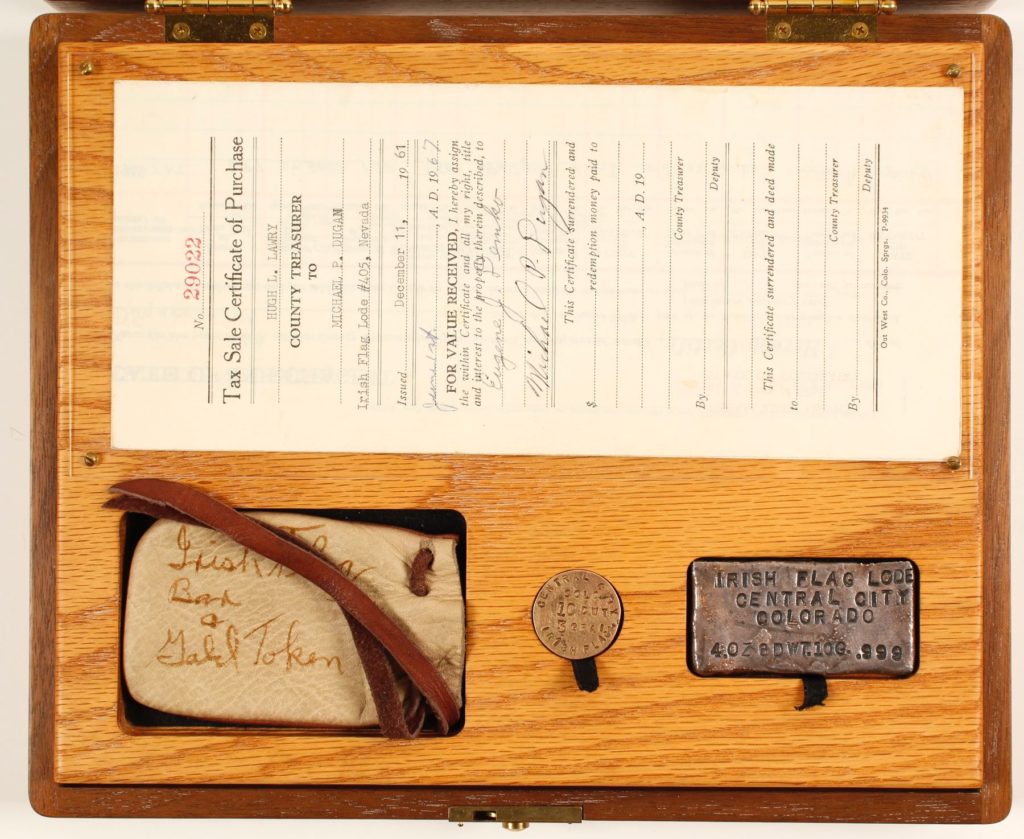
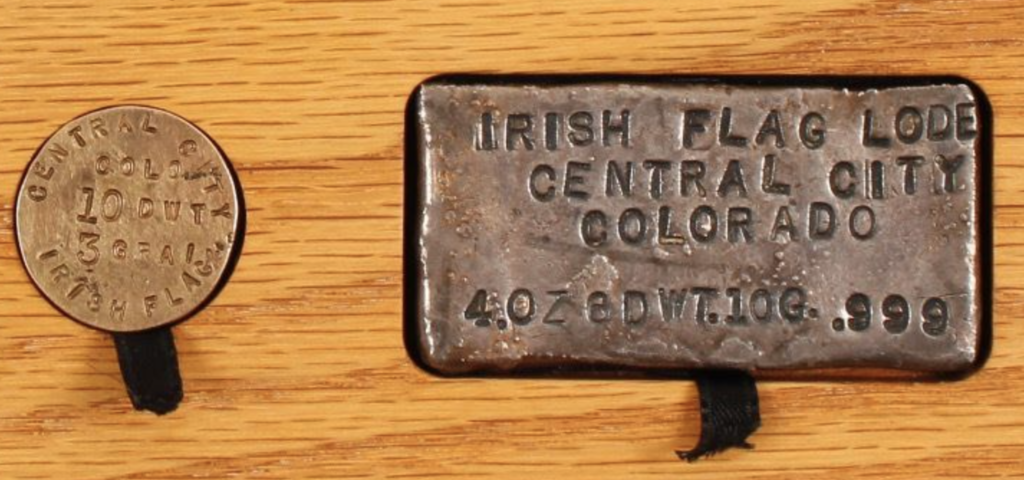
Very interesting and potentially important ingot “set” that is housed in a custom three-wood box containing some mine claim papers and a small gold and larger silver ingots and the leather bag they came in. box 11.25 x 9.5″. Silver ingot has individual letter punch: “Irish Flag Lode, Central City, Colorado, 4 oz dwt 10 g .999, 2.5 x 1.5″ ” The papers are for the sale of the Irish Flag Lode #405 in Nevada(ville), and contain a record of sale from 1961 to 1967. The lode was bought at a Gilpin County tax sale in 1961 for a whopping $9.17 to Michael P. Dugan. Dugan, in turn, sold it to Eugene J. Demko in 1967, who subsequently sold it a month and a half later to William V. Macheaney in 1967. The bag is marked with the mine name which has the appearance of being made in similar handwriting as some on the document. This box has huge implications for the ingot market. We have seen a number of silver ingots out of Colorado made in a similar fashion, as we have gold ingots made in this same style. Their origin has been long questioned by many of us , with no certain conclusive evidence anywhere. In this case, there is the appearance that the ingots may have been made by one of the men on the documents circa 1961-1967, perhaps made to help “sell” the property, or even to commemorate the property at its sale. Since the property was worth so little at the time, there is little sense in making these to “deceive” anyone, as neither the property, nor the ingots were worth much . Perhaps one of the surviving family members can shed light on this story. The round gold piece is very crude, with single punch letters “Central City/ Gold/ 10 dwt/ 3 grain/ Irish Flag//580 fine” This piece may have even been constructed of Irish Lode bullion, since the 580 fineness is unusual. The 999 fine silver bullion here is refined, and not a dore product of the mine. Date: City: Nevadaville State: Colorado HWAC# 78475
[08/2018] https://holabirdamericana.liveauctiongroup.com/Irish-Flag-Lode-Silver-and-Gold-Ingots_i30903231 ($1,312)
Gold ingot with 20th century stamp marks
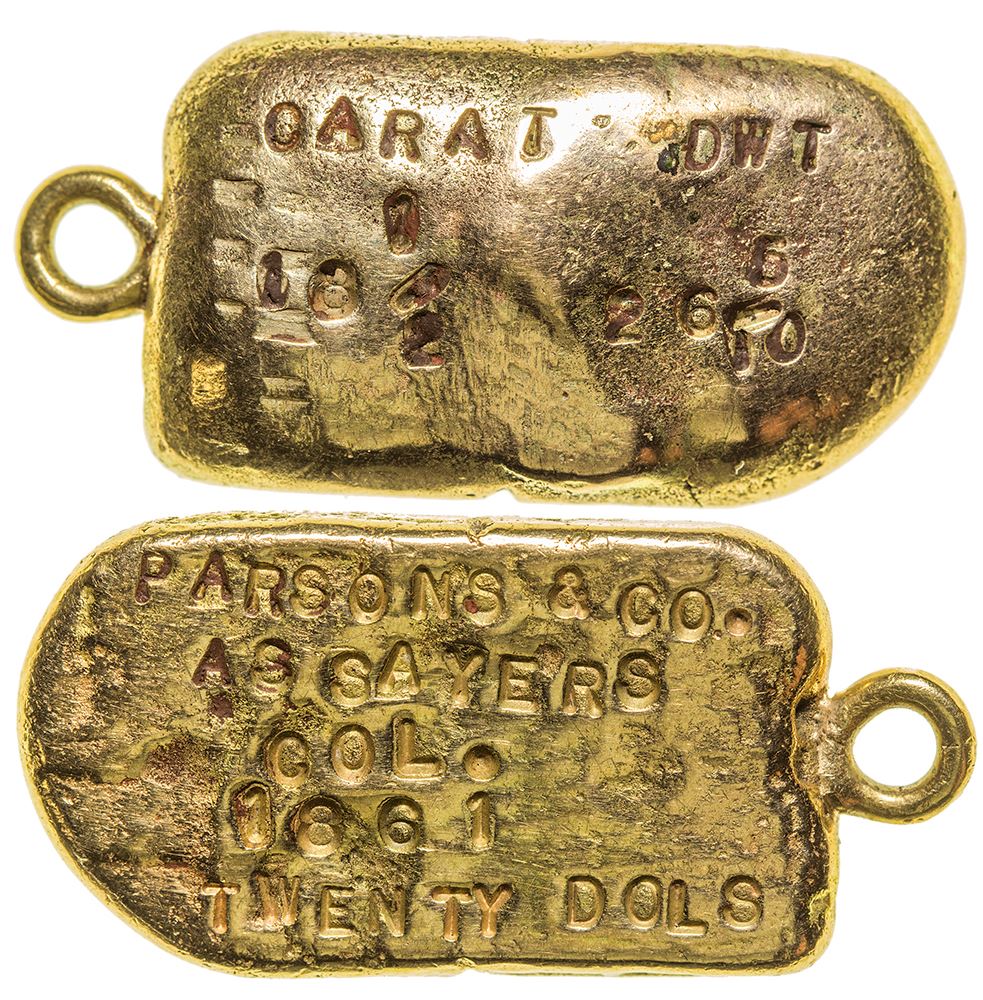
1.37 troy ounces. Ingot is real gold. Made to look like an 1861 ingot from Colorado, but the stamp marks are 20th century. Obverse lists 18 1/2 carat and 26 6/10 DWT. Reverse: Parsons & Co. / Assayers / Col. / 1861 / Twenty Dols. Ingot has loop for hanging. HWAC# 28623
[10/2015] https://holabirdamericana.liveauctiongroup.com/Gold-ingot-with-20th-century-stamp-marks_i23262967 (Passed)
Rare Golden, Colorado Ingot
Cripple Creek, Colorado Gold Ingot and Settlement Check from The Cripple Creek Sampling and Ore Co.
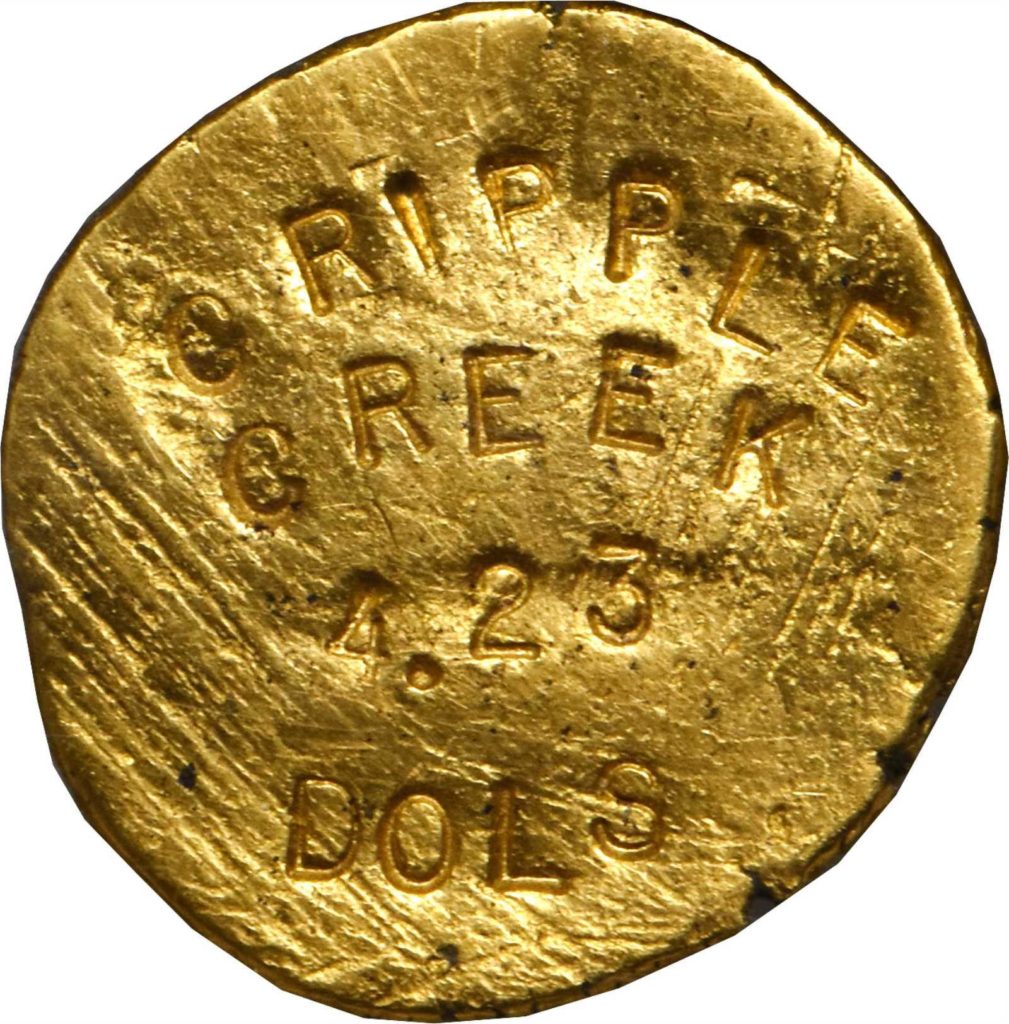
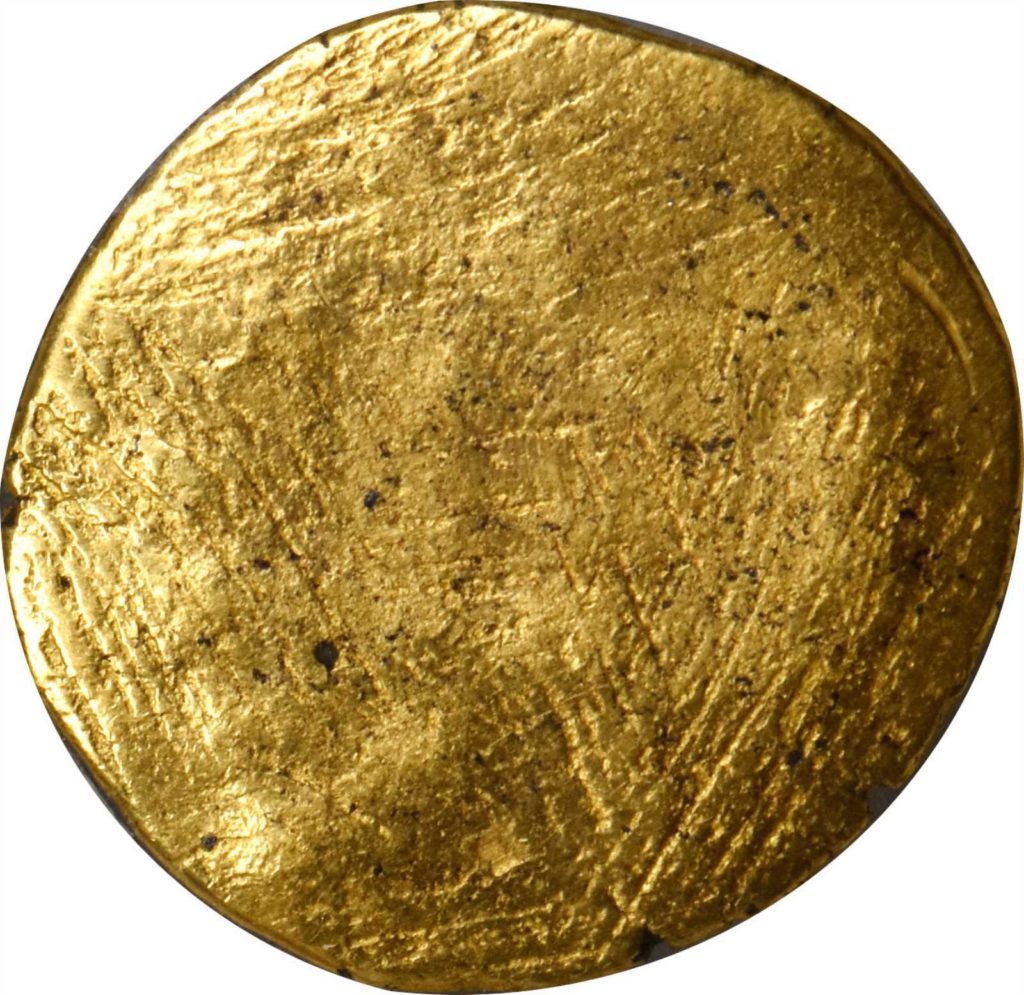
Included are an imperfectly round hammered gold ingot, 6.3 grams, roughly 19 x 20 mm, stamped with individual letter punches CRIPPLE / CREEK / 4.23 / DOLS. The condition is essentially as made, bright and lustrous.
Also included is a settlement receipt for ore bought from Mary McKenny Mining Company dated 12/8/1900, measuring approximately 12.5 by 7.5 inches. The Cripple Creek Sampling and Ore Co. was one of many mining and milling companies owned and operated by Charles Tutt (president) and Spencer Penrose (secretary & treasurer). Tutt & Penrose had a virtual monopoly on the milling of Cripple Creek ores.
[03/2021] https://auctions.stacksbowers.com/lots/view/3-Q6OVT/cripple-creek-colorado-gold-ingot-and-settlement-check-from-the-cripple-creek-sampling-and-ore-co ($19,200)
1899 W.H.R. Mining Company – Gold Button – 3.5 Ounces Gold Button
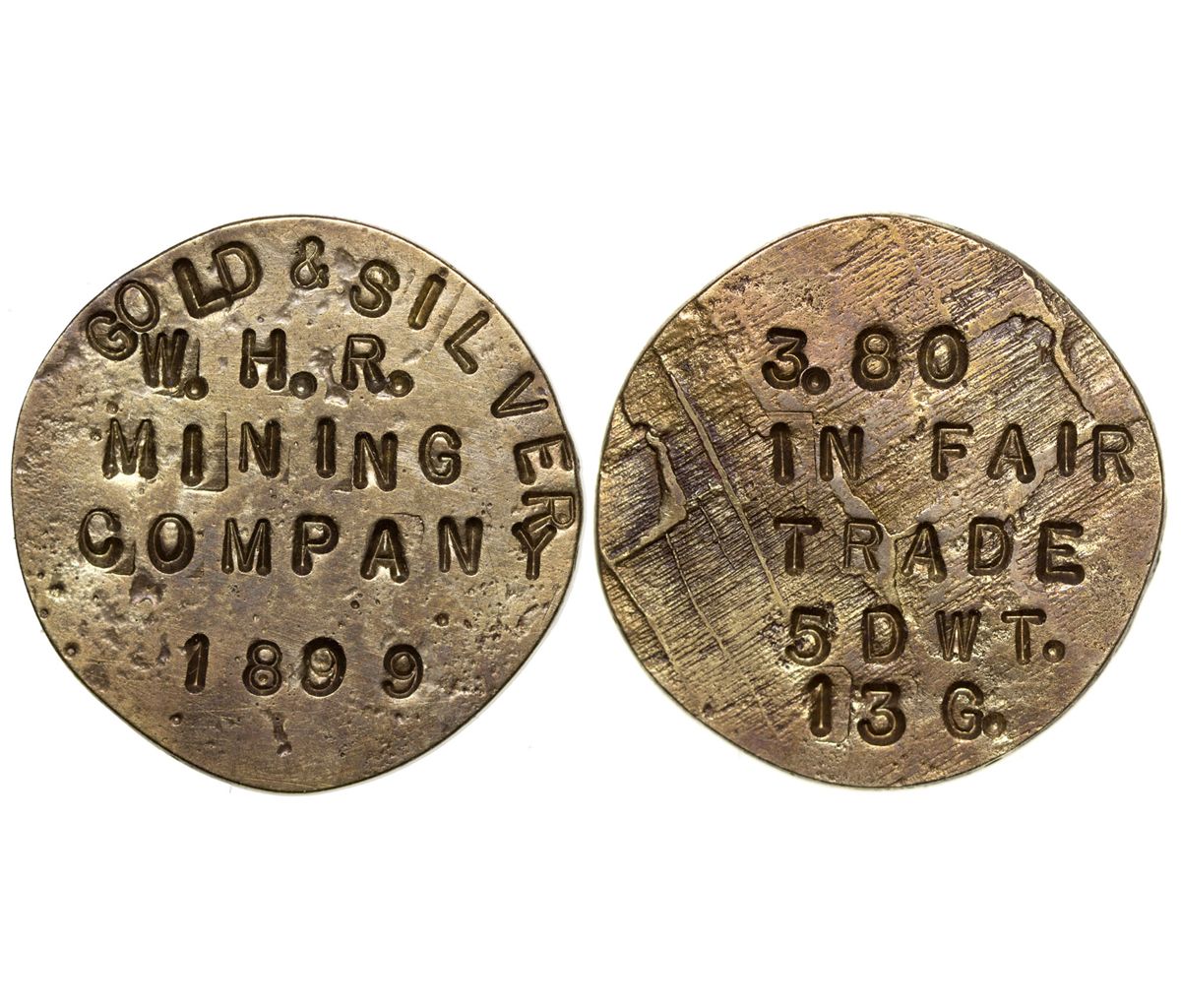
22 mm. Believed to have a Colorado connection, this piece is subject to ongoing research. The obverse reads: GOLD & SILVER / W.H.R. / MINING /COMPANY / 1899. The reverse reads: 3.80 / IN FAIR / TRADE / 5 DWT. / 13 G. Irregular surfaces with deep brown-tinted toning.
[01/2008] https://coins.ha.com/itm/ingots/1899-whr-ms-mining-company-gold-button-35-ounces/a/454-5843.s
1899 – GOLD & SILVER/ W. H. R./MINING/ COMPANY/1899//3.80/ IN FAIR/ TRADE/ 5 DWT./ 13 G. This ingot is 1″ in diameter and only 0.1” thick and weighs 0.25 troy oz. It surfaced sometime in the late twentieth century, landing in the Bass Collection. The WHR ingot was subjected to SEM/EDS analyses at American Assay Labs in Sparks, Nevada and at Florida Tech. This ingot is also not particularly homogeneous, and silver-gold contents are close to identical, with the addition of about 7% copper and 3% nickel. This indicates a non-natural source for the melt, and thus suggests a man-made alloy source for the ingot, specifically jewelry gold. This metal content precludes the piece from historical research
[12/2012] https://www.icollector.com/W-H-R-Mining-Co-Gold-Ingot_i14654258
New Silver Empire Mine Gold Ingot, CO
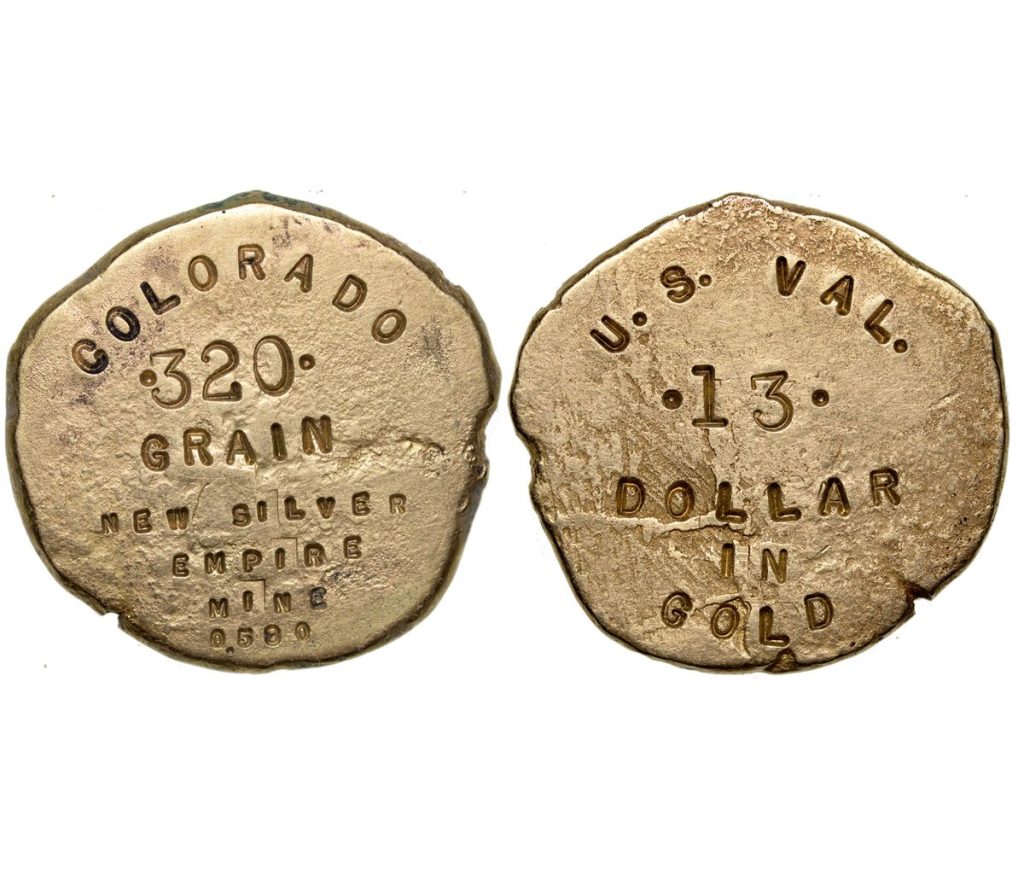
“COLORADO/ 320/ GRAIN/ NEW SILVER / EMPIRE/ MINE/ 0.580// U.S. VAL./ 13/DOLLAR/ IN/ GOLD” This 40mm diameter specimen weighs 0.66 troy oz. and surfaced sometime in the late twentieth century, landing in the Bass Collection. This ingot has been analyzed under SEM/EDS, and it has a non-homogeneous composition that includes much copper. The New Silver Empire ingot was subjected to analyses under SEM/EDS at American Assay Labs in Sparks and Florida Tech in Melbourne, Florida. Analyses varied from 4 to 18% copper (most analyses over 10% Cu), an unusually high amount for a non-massive sulfide type ore deposit product in dore form. Further, most assayers remove the copper from the dore, because it was not worth the effort to retain. Gold and silver were the key paying metals. Thus its inclusion in this dore makes the origin of the melt suspect. It most probably came from melting of gold scrap and coin, which contains copper as a man-made alloy. With this new fact, any history of the new Empire mine is relatively meaningless.
[12/2012] https://www.icollector.com/New-Silver-Empire-Mine-Gold-Ingot-CO_i14654262
1904 Economic Gold Extraction Co. Gold Ingot. 220.4 dwt
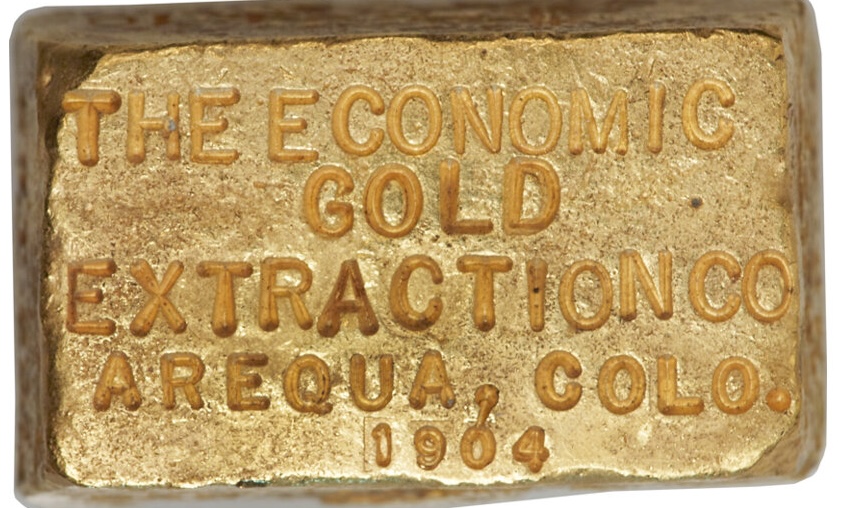
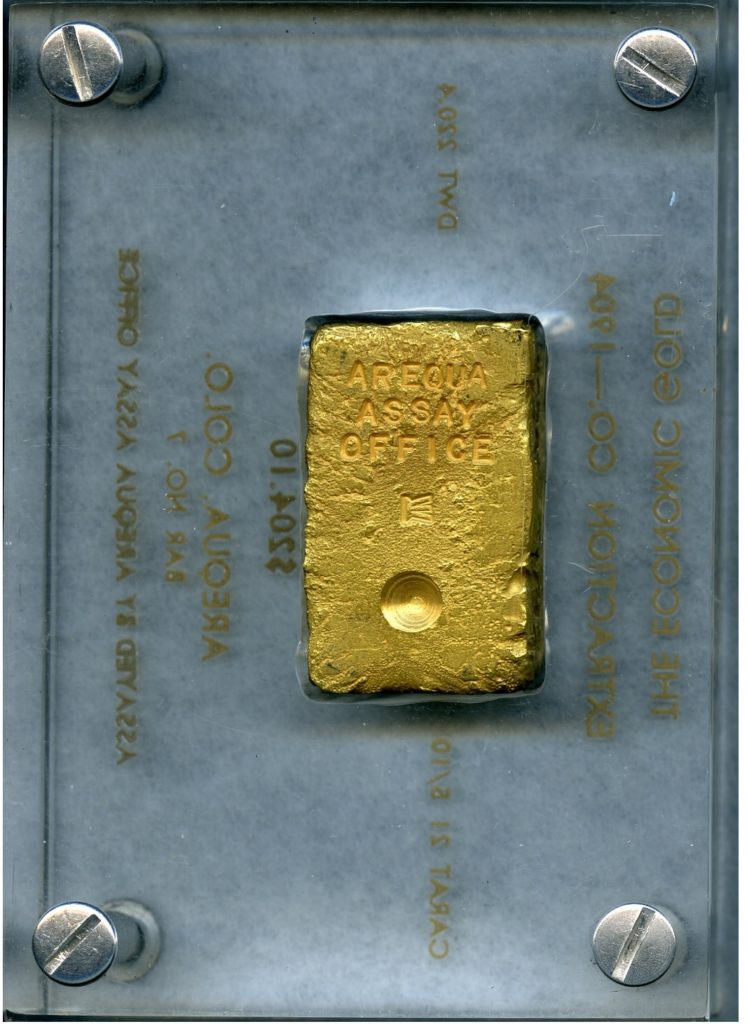
Assayed by the Arequa Assay Office in Colorado and dated 1904. Everything is included except the weight in ounces on this small ingot. It is 21 5/10 carats, 220.4 dwt., and valued at $204.10. This is Bar No 7.
From Christopher Bently’s Nob Hill Collection.
[02/2014]= https://coins.ha.com/itm/ingots/1904-economic-gold-extraction-co-gold-ingot-2204-dwt/a/1203-4377.s ($12,925)
1905 Wild Horse Consolidated Manufacturing Co. – Gold ‘Button’ 2.3 Ounces
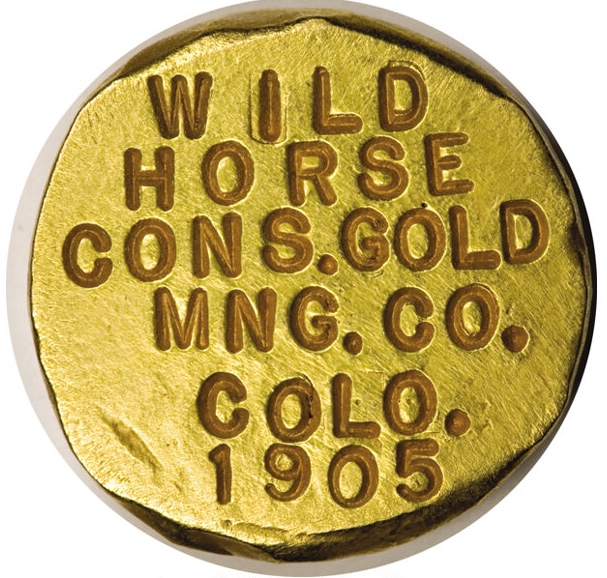
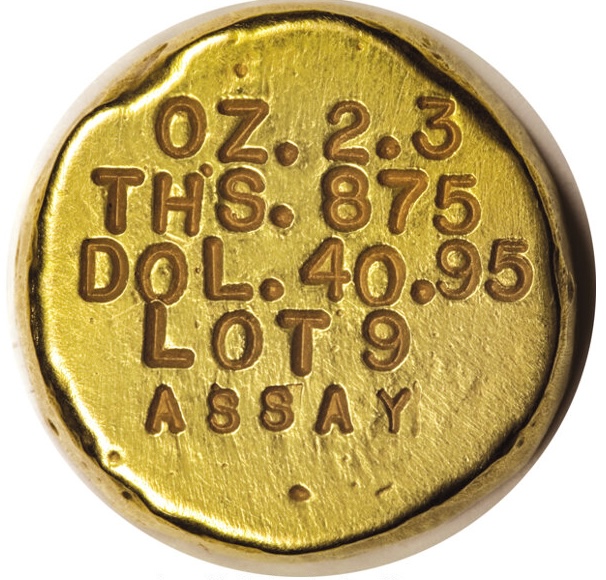
Believed to be related to the W.H.R. button, but this link has not been proven. Stamped on both sides. One side reads: WILD / HORSE / CONS. GOLD / MNG. CO. / COLO. / 1905. The other side reads: OZ 2.3 / THS. 675 / DOL. 40.95 / LOT 9 / ASSAY. Measures: 27 mm.
[01/2008] https://coins.ha.com/itm/ingots/wild-horse-consolidated-gold-manufacturing-co-gold-button-23-ounces/a/454-5844.s (Passed)
1905 – This small gold ingot is individually letter punched “Wild/ Horse/ Cons. Gold/ Mng. Co./ Colo./ 1905// oz. 2.3/ ths.675/dol.40.95/lot 9/assay”. The actual weight is 2.22 troy oz. and it measures 1.1” in diameter and 0.25” thick. It surfaced sometime in the late twentieth century, landing in the Bass Collection. The Wild Horse ingot was subjected to analyses under SEM/EDS at American Assay Labs in Sparks and Florida Tech in Melbourne, Florida. The content is relatively non-homogeneous, showing varying amounts of gold. It is generally of high purity, with sample points varying from 82% to 87%. Silver analyses varied from 1% to 2.5%. The presence of copper in amounts from 2% to about 7% call into question the origin of the metal before the creation of this ingot product. Copper was usually removed from dore because it had no value. It was only retained by certain assayers in a manner to illustrate the copper content of the ore, especially if the ingot was used in an exhibition showing off the ore and its metallic product, the ingot. Examples of this exact thing are known from western assayers Thomas Price, Henry Hanks and Conrad Weigand. Each of these assay bars was the product of a silver-gold-copper camp, and each ingot bears the unmistakable legitimate assayer’s punch. The presence of copper in a high purity gold ingot renders its metallic origin suspect to me
[12/2012] https://www.icollector.com/Wild-Horse-Gold-Ingot-Round-CO_i14654263
Round Coin Size Central City Silver Ingot
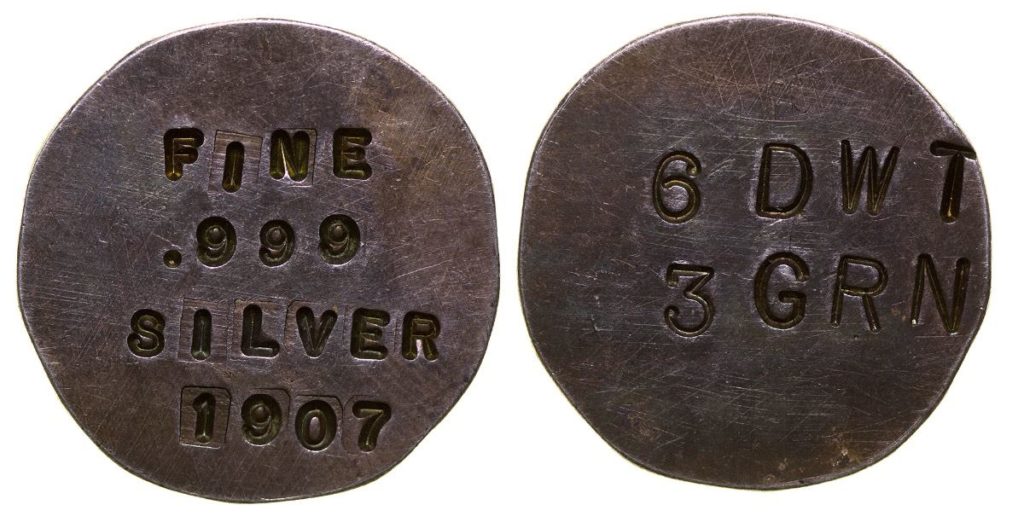
Silver ingot. Round. 25mm, hand made. “6 dwt, 3 Gr” on one side, “Fine 999 Silver 1907” on other side. 0.30 oz troy. This silver piece comes from long time Colorado dealer Dan Brown Collection, purchased by our collector in August, 1979. It says “Central City” on the small blue paper coin envelope. This piece is of extreme interest. Over the years, I have seen a number of similar pieces, all hand made, and all crudely punched as is this specimen. In fact, I’d wager that all were made by the same person. Until now, I thought all were possibly fake, fantasies made to fool collectors. But this piece may tell A DIFFERENT STORY. Firstly, it has no mine name. secondly, it is dated. This leads me to believe that it may have been made in 1907, and it may have been made for an exposition, showing off the metal product from silver ores from some unknown mine. But why the non-standard weighing system?, and why the apparent refined silver? I have indeed seen references to the “old” weighing system from circa 1900, but not by standard mining men. Were there mines in Colorado that produced only silver, with little or no byproduct? Yes. But the Central City notation stumps me. This is a gold district. I then expected to find an exposition in central City in 1907. I cant find a record of one in the Mining and Scientific Press or Engineering and Mining News. The only conventions of note were a conference of the Western Federation of Miners in Denver in 1907 and the American Mining Congress meeting in Joplin, Missouri in 1907. The WFM wouldn’t have had displays. The WMC articles mention exhibits of Joplin area ores and products. This piece thus requires more research- can we find it specifically mentioned in a Central City newspaper? -fh City: Central City, Gilpin County State: Colorado, Date: 1907 Inventory# 41224
[10/2016]= https://holabirdamericana.liveauctiongroup.com/Round-Coin-Size-Central-City-Silver-Ingot_i25648970 ($186)
.5 oz, 1911 ingot or “splash.” Central City, Colorado. As issued or nearly so.
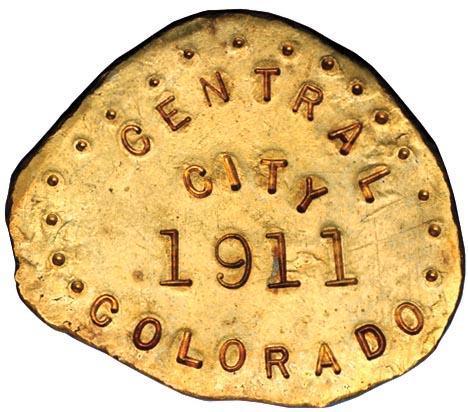
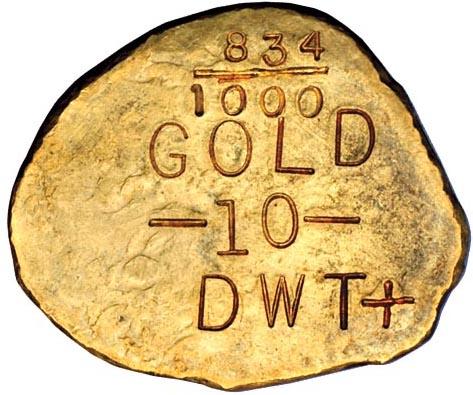
246.0 grains. Roughly 24.0 x 28.5 mm in an oblong form. Obverse stamped in individual punches: CENTRAL / CITY / 1911 / COLORADO with 17 decorative beads. Reverse stamped in individual punches: 834/100 / GOLD /—10—/ DWT+. The “+” sign is made with two separate “I” punches, and the fraction bar is similarly constructed. Attractive lustrous light yellow gold with few surface flaws, just some light hairlines. Very interesting and attractive aesthetic appeal. A unique item, to our knowledge, which rather reminds us of the extremely rare 1907 Baker City, Oregon 2 ounce splashes. The weight of this piece is just short of that of a $10 eagle, whose statutory weight is 258 grains at .900 fine. Central City was near the epicenter of the ca. 1859-1860 Colorado Gold Rush, with the city so named for its proximity to other gold camps. Its population swelled to 60,000 shortly after the gold strikes though it numbers in the hundreds today. By 1911, the population had waned severely and little gold was mined after the 1920s, placing this ingot or splash near the end of Central City’s life as a prototypical gold camp. While authenticating splashes such as this is a challenging proposition, based more on experience with similar objects and instincts than a definable standard, we believe this one is what it purports to be, a personal souvenir from the last days of a well-known gold camp rather than an ingot or anything with currency value. This piece appeared in Colorado, from where it was consigned, and we have good faith in it. It would be an interesting addition to any collection of ingots or private gold issues.
[08/2006] https://auctions.stacksbowers.com/lots/view/3-AQW9K/1911-ingot-or-splash-central-city-colorado-as-issued-or-nearly-so ($1,667)
1908 Big Five Mine Silver Ingot. 2 Ounces, 18 Pennyweight.


The Big Five Mine was first discovered in 1861, but the mine was not extensively worked until the 1890s. Possibly a presentation ingot, as dore ingots were generally not made from refined silver. Stamped on both sides. One side reads: BIG FIVE / MINE / WARD COLO. The other side reads: .999 FINE / MAY 1908 / 2 oz. 18 d. Measures: 21 x 42 mm.
[01/2008] https://coins.ha.com/itm/ingots/big-five-mine-silver-ingot-2-ounces-18-pennyweight/a/454-5838.s ($3,450)
Opal Bee Mining Co. Silver Ingot. 6 Ounces, 16 Pennyweight
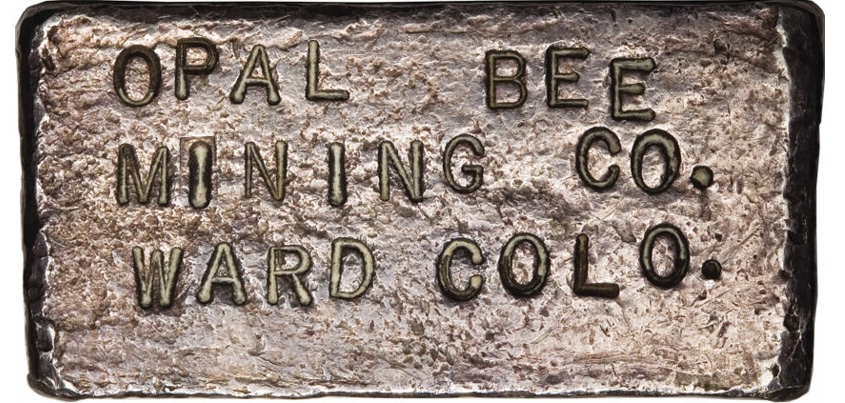
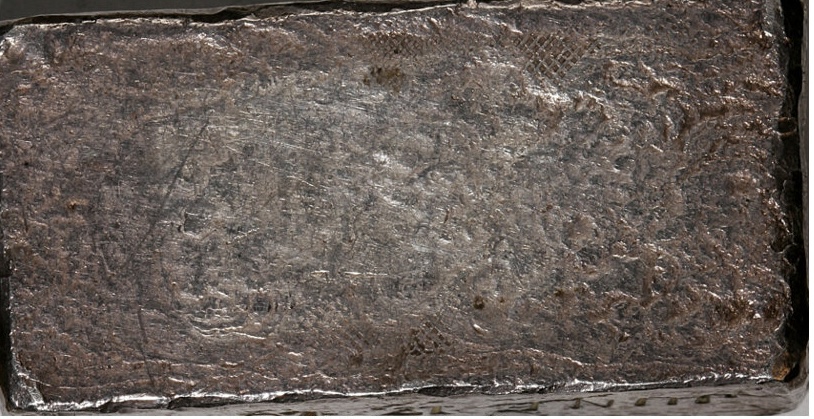

When Fred Holabird is stumped about the origin of an ingot, that is a testament to how elusive and truly rare it is. Judging from the lettering style, this appears to have been produced after 1910. Let us just say this is a good research project for the interested collector of Western assay ingots. On the top side, the bar reads: OPAL BEE / MINING CO. / WARD COLO. The long, bottom side has an indeterminate date with the third digit of the year overpunched, appearing like a 7 punched over a 3. That side reads: JUNE 17, 183/78. The short, right side reads: 6 OZ 16 D (sideways) / FINE / 999. Light-medium gray patina. Measures: 24 x 51 mm.
[01/2008] https://coins.ha.com/itm/ingots/opal-bee-mining-co-silver-ingot-6-ounces-16-pennyweight/a/454-5840.s (Passed)
1907 Silver Octagonal Coin

“Fine Silver/ 1907/ 91/ Grain// blank. 25.5mm. Comes with original Dan Brown envelope and Neuman envelope. 1907 Colorado Silver Pieces Modeled After Lesher.
Fred Holabird
Introduction
With the sale of some of Eric Newman’s fabulous coin collection, items are coming out of the woodwork that lend themselves to new discoveries. Such is the case here.
Three silver pieces were recently sold from Newman’s collection with the original coin envelopes from Dan Brown, the prominent Denver coin dealer for decades, active in the 1950’s-60’s (approximately). These three pieces are very similar to two gold pieces we’ve handled over the years that I previously reported as “suspicious” or possibly fantasy pieces. The two gold pieces were lacking in any original information retained with them. Now, with more data, a story opens up.
Specifically, Brown’s envelopes, with his own handwriting, appear to pre-date the known late 1960’s fantasy pieces. Ostensibly Newman purchased the three pieces as original, and happily for collectors, he retained the original collecting envelopes. Further research in the newly opened digitized files of Eric P. Newman shed light, as did research by this author about 15 years ago when an unusual group of silver ingots appeared from an unknown Colorado collector, sold through a California dealer.
None of the three pieces here have any designation of state or other geographic origin, nor do they contain the name of the issuer. Each is, however, dated 1907, as did one or more of the similar gold pieces.
After extensive research, a conclusion can be drawn. But first, the data.
Background
Lesher and his Octagonal Silver Coins
Joseph Lesher produced a silver “dollar” in 1900 that he hoped would form a basis of circulating silver, a monetary product that memorialized the Cripple Creek District and promote the use of the silver from Colorado’s many silver mines. Indeed, Lesher himself had a silver mine at Georgetown in 1892, and was a man who was the epitome of the western prospector – a man that moved from mining camp to mining camp seeking fortune over a 25 year period.
Lesher himself spent time in a number of western mining camps – Aspen, Georgetown, Leadville, Silverton, Cripple Creek (Victor), and perhaps more. After the failure of the Lesher Dollar scheme, he moved to several Nevada silver-gold camps, all close to one another in west central Nevada (today, 2.5 hours east of Reno in the middle of nowhere). The central, and largest camp was Wonder, Nevada. On the southern flank of the valley was Fairview, and high up in a remote canyon north of Wonder was the tiny mining camp of Hercules. It lasted a whole year. Further to the north was the booming Rawhide, where Lesher moved after Wonder. Whatever Lesher was doing in these camps, it didn’t work, and he soon moved back to Victor, Colorado.
Lesher wanted a legal form of private money, and solicited advice from attorneys and the Secret Service. Instead what he got were his dies confiscated. In late fall, 1900, Lesher was told he needed to change the wording on the coins to make them more like trade tokens, using a phrase such as “good for merchandise” etc. He thus enlisted a number of merchants and had their names placed on the coins, circumventing Federal Law prohibiting private money.
One of Lesher’s problems was buying the silver itself. He was not a wealthy man, and his plan depended upon the merchants “buying in” to his plan and product, which paid for the silver. It goes without saying that Lesher thought the silver market would remain stable.
Lesher applied for a patent on his new, beautiful silver octagonal “Referendum Dollar”. Though there was excitement in the use of these coins at first, Lesher’s main merchant to circulate the coins, A.B. Bumstead, died unexpectedly, thus plugging a hole in the key to his circulation plans. By mid year 1901, he had trouble finding merchants to buy the coins, and by 1903, the last of the Lesher Dollars was mentioned in Leadville. While circulation of the Lesher Dollars as currency seemed to have stopped, the collecting public were hot at it. Researcher and author Robert Leonard reported that collectors were busy buying the Lesher Dollars in 1904 and 1907, according to articles he found in local press.
Shortage of Circulating Coinage
Western merchants, in the meantime, continued the use of trade tokens at their establishments, primarily saloons. This was another form of private money, but die sinkers continually side-stepped the Federal laws on private money. The classic wording just after the turn of the century was “Good for (X) Cents In Trade”. Western merchants were unlike many others in America, because the boom and bust nature of the mining camps kept them short in circulating money, especially the mining camps that didn’t last long enough to have a bank, the central source for circulating money.
Mining Booms Create Western Mining Stock Frenzy
By 1906, many of the post-1900 mining camps, as well as the ones that had been successful for decades, began to see a corporate consolidation of mining properties. Hundreds of thousands of shares in tiny mining company stocks were bought and sold, many on simple rumors of high grade ore. Larger public companies were formed, buying and consolidating many properties – both producing, and those that had never mined a ton, but might have been adjacent to or near a producing mine. Goldfield Consolidated is a great example, buying most of the better mines in Goldfield, Nevada and placing them under a single ownership for better and cheaper future development. But as the consolidation process took hold, it allowed scammers to operate more freely under the radar. Small properties, many with no production whatsoever, were bought up by hopeful promoters, with the goal of selling to a major mining firm. Men such as George Graham Rice, who wrote “My Adventures With Your Money” from prison, and other promoters such as L.L. Patrick, who used similar sales tactics but never was convicted, began selling shares in mining companies that were based entirely on “wishful thinking.” When the stock went nowhere fast, or started out with a bang, only to drop to nothing within months, people lost fortunes.
A financial panic ensued. It got rolling about mid-1907, lasted well into 1908, some say through 1910, and was complicated by miners union activism resulting in labor strikes in Colorado, Idaho and Nevada. Men were murdered. There was chaos in many of the greater western mining camps. Investors lost confidence in mining ventures.
The Silver Market
Part of the panic was the direct result of the fall of silver prices in 1907. Silver prices had risen steadily from 1902 to 1907 from 55c/oz to 68c/oz. This would have fit perfectly into Lesher’s plan for a circulating silver piece. But the stability and rising price model of silver prices was about to take a drastic change. In April 1907, silver dropped to 65c. It rose again to 69c in August, only to see a precipitous drop to 54c in December, a massive 22% fall. This is nothing short of a market crash. But it didn’t stop there- the price continued to drop, hitting 48c in December 1908 – a full 30% collapse. The Mining and Scientific Press reported many mines closing, particularly after October.
With the collapse of the silver market came the closure of mines, and with it a slow down in cash production, hence fewer and less bank deposits. Western banks that had sprung up nearly overnight in small mining camps, survived on deposits. Those deposits came crashing to a halt when the mining stopped, whether from the lack of ore, from the lack of exploration funding, or from unionism activity. That meant failure for the banks. In Nevada alone, more than a dozen banks or branches of banks went kaput.
While there were problems in the financial sector, gold and silver production was still strong. Colorado mines produced about $28 million in 1907, down from about $32 million in 1906. Much of the reduction was from falling metals prices.
Miners Unions and Radicalization
In 1907, extensive efforts were made by the Western Federation of Miners (WFM) to unionize mine labor. The big targets were Nevada and Colorado mines. The WFM was hell-bent on raising wages, and the mine owners dead set against it. Nevada mining companies were already paying higher wages than any other states. In November, 1907, after a union shooting in Goldfield, the Goldfield Consolidated told employees that half their pay would be in company scrip. The WFM voted to reject it, and at least one outfit issued a form of humorous scrip, figuratively tearing apart the Goldfield Consolidated scrip system. This was a form of radicalization, and the silver coins here fit right into the miners union wage debate.? Are they a crude form of miners union scrip?
Circulating Coinage and the 1907 Colorado Silver Pieces
This period was the height of the western trade token era. Merchants had insufficient pocket change, so they used their own, made by regional die sinkers.
In this light, it appears an unknown merchant re-examined Lesher’s model of trying to circulate precious metal pieces as money. The pieces are likely a form of prototype, possibly issued in July to August, 1907, when silver prices were high. But the precipitous drop in silver price of 20% to 30% over the next few months doomed the venture, and it never got off the ground. Few merchants, let alone a clever marketing man could withstand this level of silver market collapse.
The Colorado silver pieces are individual letter/number punched. They also do not contain an issuing name or place This indicates a prototype. Here’s some of my reasoning behind this concept.
One possibility for these silver tokens is that they could have been used to promote a mine’s product at a mining exposition. There were none in Colorado in 1907 – not a single mining or industrial exposition. Could they be from other states? Maybe, but they came from Colorado’s top coin dealer Brown, which indicates their possible source as Colorado. Brown’s envelopes indicate Central City, but Central City sounds to me like a guess, since that district’s major product was gold, as was neighboring Black Hawk. Nearby silver camps included Silver Plume and Georgetown, where there were also a number of precious metal smelters.
There is no mention of any promotional items like this in the 1907 issues of the Mining and Scientific Press, issued weekly, the largest mine publicity organ in the country at the time. I can find no mention in any of other mining promotional materials.
An anomaly observed on the pieces is the weight presented, all in grains and pennyweights (DWT). This is an important data set because the use of grains is standard within the US Mint system, as well as silver and goldsmiths, since the beginning of the US Mint in 1792. This form of weights/measures is not used by the mining industry. Mining interests use Troy ounces, and have for centuries. Thus the conclusion that the silver pieces here were made for monetary circulating use.
The Weight as a Unit of Money
The weight of the two octagonal silver pieces is 91 and 161 grains, as stated on the coins. If pure silver, this equates to 0.190 troy ounce and 0.335 troy ounce. In August, 1907, the pieces had a face value of 23 cents for the 161 grain piece, and 13 cents for the 91 grain piece. If silver had risen to 75 cents/ounce, the 161 grain piece would have been worth 25 cents, and the 91 grain piece 15 cents.
With a “floating” and unsteady silver price, it would be nearly impossible for a merchant to calculate or predict the value of a circulating specie like these coins, and thus have them acceptable to merchants and the public. Thus any attempt to make a circulating specie in silver was doomed to failure. The denominations of 15 and 25 cents, at 75 cents per ounce silver, fit nicely into the circulating private minor coinage (trade tokens) of the period.
Construction of the Three Silver Colorado Pieces
In light of and in need of direct comparison of the three pieces here to the rather fanciful gold pieces of a purported similar time frame and origin, it becomes necessary to closely look at the construction of these three pieces using a binocular microscope.
The round piece is the exact same thickness as the 161 grain octagonal piece, at 1.8mm thick. I looked at it to see if it was of a uniform shape cut as a planchette from a sheet. It is not. It is not perfectly round, as would be expected from a die sinker. The edges indicate it was finished off by a fine grinding wheel.
The 161 grain octagonal piece has non-parallel sides, also indicating it was not struck in a standard manner from a die cur rendering an octagonal planchette from a uniform thickness sheet.
The second octagonal piece, 91 grains, is a thin 1mm. It was possibly cut out in one piece, but is struck on a very crudely rolled or pressed silver planchette, where layers are clearly visible in the edge, perhaps not typical of a machine rolled sheet from which a die cutter might punch an octagonal planchette.
The major difference of these three pieces from the gold pieces is the simple fact that the other pieces, similar in size, but of gold composition, all have fanciful mine names, and in one case, two completely different weighting systems, atypical of any normal legitimate pieces.
If these were in fact proto-types, it might be assumed that they would have been made by a die sinker as examples. But they appear too crude for such an assumption. But were they made by a non-diesinker merchant? Were they made by a guy following in the footsteps of Lesher to see how people would react? This, I’m afraid, we’ll never know.
New Evidence from Eric P. Newman
Well known American numismatist Eric P. Newman recently helped fund a new research tool, the Newman Portal, in which important research material is digitized and made available to the public for free.
Mr. Newman included some copies of correspondence he had with Denver coin dealer Dan Brown in 1964. The three letter sequence from April indicates that Newman purchased from Brown some 1907 silver pieces, which I assume are these pieces in question, as well as others generally referenced in the letters, possibly the same as those I have seen and mentioned previously. Portions of the letters are too good to miss:
April 14, 1964, Dan Brown to E.P. Newman:
…thought I would check mainly to see what you thought about the 1907 items as I have a couple more of these and am wondering if they are genuine or not.
John Ford has seen some of these and his opinion is that they are not genuine, but then again, if they were his, it might be that they would be genuine. It would be interesting to find out either way…
April 17, 1964, Newman to Brown:
…I was intending that you would furnish me the information on the 1907 items. I frankly know nothing about them.
What you say about my friend, John Ford, is outrageous, but I agree with you. I believe I could straighten out the entire matter of fakes of Western Americana with a polygraph test. Don’t you know even the source of these pieces?…
April 20, 1964, Brown to Newman:
…in regards to the 1907 items, I have purchased them from a young fellow who reportedly goes around to these various little mining towns in Colorado, once in a while buys up some property for back taxes, checks with people who have lived there for years and digs out coins and things of that nature from them, at least that is his story. Whether it is so, or not, I do not actually know, but it seems to ring fairly true. He has told me various places he has been, people he has seen and has come up with such things as stocks and bonds issued during the mining days for so many shares, as well as other interesting coins and information. Whether it is true or not, though I have no way in the world to know. He seems to know quite a bit of the Pioneer days here in Colorado through his visits with the people and talking with them. Whether he is making these bars or actually getting them, only he might know…
Other Hand Punched Ingots from Colorado
Over the years, a number of pierces have arisen into the collector market, reportedly from Colorado. None were published publicly prior to perhaps 2000. I reported on these in several articles and public lectures. The first were a few silver ingots, all rectangular, all hand punched from various assayers. This group had reportedly come from a Colorado collector through a California dealer. Two of these are shown below.
Two gold round pieces also came into the market place, both hand punched, and both of the “post-1900” period. These are seen below.
A third group came into the marketplace, which were sold as fantasies about 2013. They most closely resemble the three pieces here.
Comparisons of the Brown Silver Pieces to Similar Colorado Pieces
It is inevitable to make comparisons of these groups of precious metal pieces. Perhaps of key concern is the fact that not a single one of these pieces was known or documented prior to 1964. This is important, but it is not a deal breaker. To illustrate the point, the known Goldfield Consolidated mining scrip is mentioned, but not known today. The humorous anti-mining company scrip is mentioned in some news articles, and is known today. But metallic scrip from western mines is not mentioned in the historical quarter, with the exception of the California and Colorado Gold Rush pieces of the 1840’s-1860’s.
Of the pieces here, none resemble the three silver pieces of this lot, except the latter pieces, which are not pictured here. Were they part of the original group Brown mentions? There is little similarity to the precious metal pieces that mention specific mines or assayers, pieces which at this time are considered questionable in origin.
The 1963-1964 period bears further discussion. The US Mint had announced it would be dropping the use of silver in US coinage at the end of 1964. This created a mini silver rush. This is the first of the modern periods where silver items started coming out of the woodwork. The next period was perhaps 1975-6, after the Gold Reserve Act was repealed and silver prices rose. The third period was the “Hunt Bros.” debacle, when silver went up to $50/ounce. The three silver pieces here could easily have come out of the woodwork during this first silver “rush”.
Clearly, Newman questioned Brown on these pieces. Ford offered his opinion, rejected by Brown and Newman. The discussion by Newman was echoed in Karl Moulton’s book on Ford. It is inconclusive at best.
Is this “body” of precious metal “coinage” from Colorado, all c 1905-1908 legitimate? Is some of it legitimate? Curiously, these pieces feed directly into the actual historical record and the silver market record, if they were intended as minor coinage.
Conclusions
A stack of data leads to the inevitable conclusion that these Colorado silver pieces were made for the purpose of circulating coinage.
1. There is nothing in the mining press discussing Colorado mining exhibitions in 1907 at which to promote mines and their products.
2. The weights stated on the coins are in grains/DWT, a standard of the US monetary system.
3. This weight system strongly indicates the coins were not made for the mining industry.
4. The octagonal nature of two of the pieces does not appear to be random, and may reflect the issuer’s knowledge of the Lesher Dollar.
5. The timing of the issuing of the piece coincides with a rising silver market, a key in the potential of mass marketing these pieces.
6. The face value of the pieces would have been equivalent to circulating trade token values if silver had risen just 6 cents per ounce to 75c/oz.
7. The timing of the pieces perfectly coincides with mining union/anti-union scrip.
8. Similar pieces found in the numismatic market all carry mine names or similar attributes. These pieces are questionable, but are explainable by virtue of mine promotion.
9. The tie between the pieces mentioned in #7 above with the three pieces here is the use of grains/dwt. Is this crossover legitimate?
10. The lack of more pieces made in a more formal die struck manner indicates these are a prototype.
11. The lack of more circulating pieces coincides exactly with the silver market crash of fall to winter 1907, resulting in an end of the project.
Through time, as more and more newspapers become digitized, I suspect a researcher will find more on these pieces. Date: Location: Colorado HWAC# 53363
[03/2018] https://holabirdamericana.liveauctiongroup.com/1907-Silver-Octagonal-Coin_i29369884 ($750)
Round 1907 Silver Coin

25mm, “fine/.999/ silver/ 1907// 6 dwt/ 12 grn” with original dan brown envelope and Neuman envelope. 1907 Colorado Silver Pieces Modeled After Lesher.
[03/2018] https://holabirdamericana.liveauctiongroup.com/Round-1907-Silver-Coin_i29369885 ($750)
1907 Colorado Octagonal Coin

Octagonal silver 161 grains, Pure, 1907, 25.5mm. Unique, similar to at least one other silver and one other gold pieces. Comes with original white Dan Brown envelope and brown Neuman envelope. State: Colorado Date: HWAC# 53364
1907 Colorado Silver Pieces Modeled After Lesher.
Fred Holabird
[10/2017] https://holabirdamericana.liveauctiongroup.com/1907-Colorado-Octagonal-Coin_i28118923 ($484)
[03/2024] https://bidnow.vegascoindealer.com/Listing/Details/223194/1907-Colorado-Silver-Specimen-from-the-Eric-P-Newman-Collection ($1320)
Bitron Gold Ingots – many examples exist. They seem to be related to the above cluster of ingots by region and punch style.
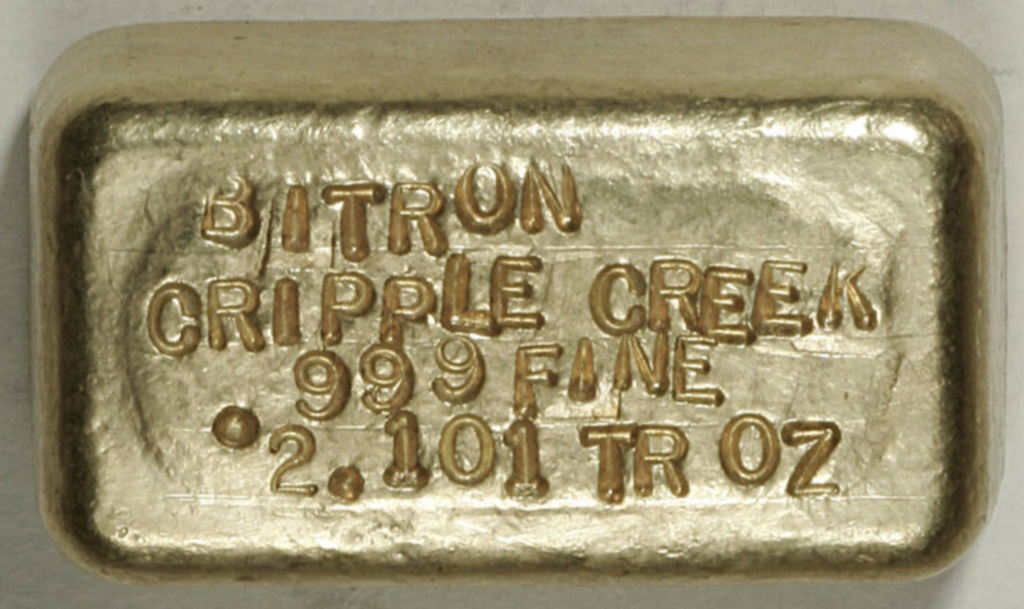
3 oz CO – Leadville,Lake County – Leadville Colo. Ingot
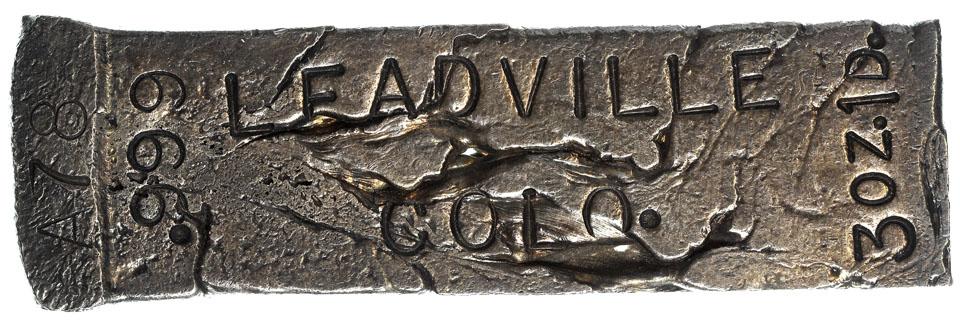
[06/2011] https://www.icollector.com/CO-Leadville-Lake-County-Leadville-Colo-Ingot_i10678907 ($999)
16.11 oz Gold Bug Mines Silver Bar – Colorado
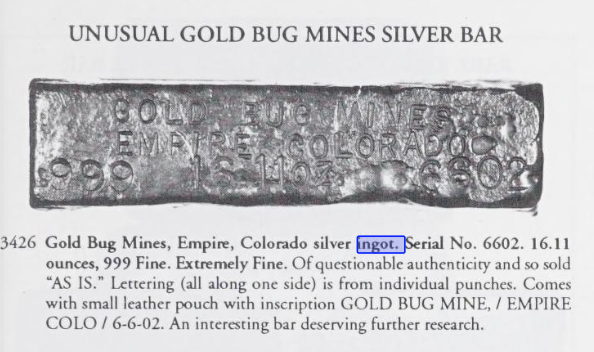
[02/1992] https://archive.org/details/centurycollectio1992supe/page/344/
Silver Ingot. Creede. Colorado
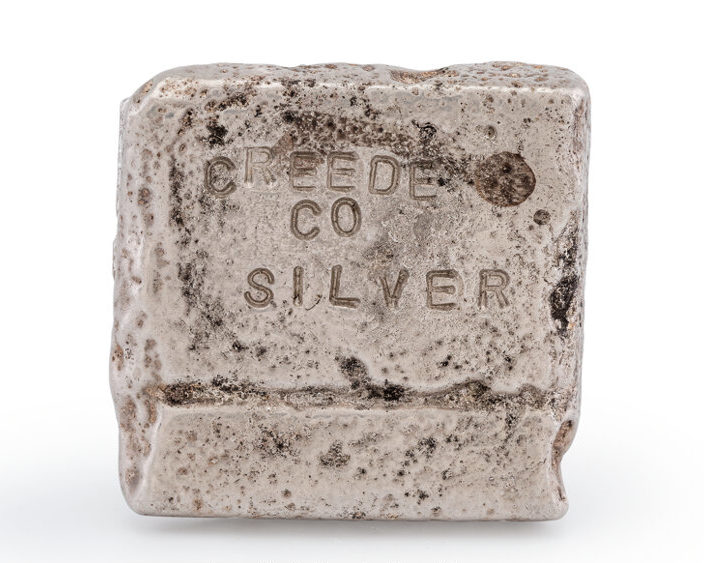
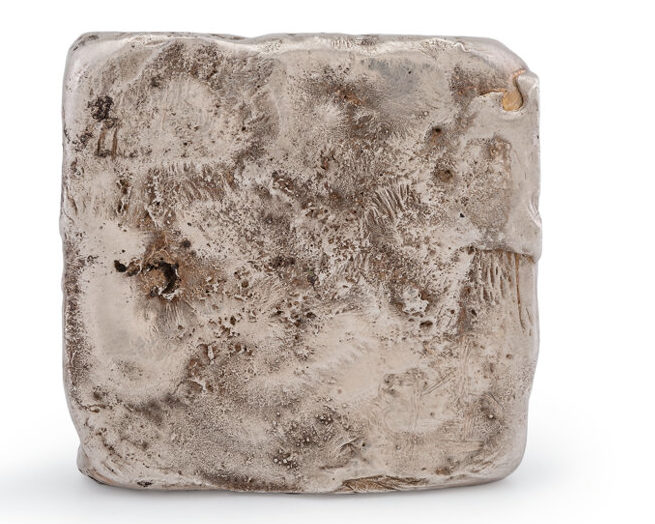
Creede
Colorado, USA
1.87 x 1.81 x 0.41 inches (4.76 x 4.60 x 1.03 cm)
This ingot bar represents 167 grams of .999 pure Silver from the town of Creede, Colorado founded at the end of the Silver Boom of 1869. This piece has both historical significance and appearance offering well over 5 troy ounces of that precious metal. Colorado and Creede are both synonymous with Silver.
[12/2021] https://fineart.ha.com/itm/minerals/native-metals/silver-ingot-creede-colorado-usa-187-x-181-x-041-inches-476-x-460-x-103-cm-/a/212149-77026.s ($2,750)
